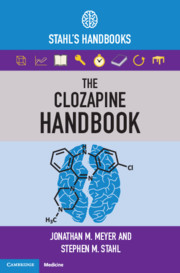Book contents
- The Clozapine Handbook
- The Clozapine Handbook
- Copyright page
- Additional material
- Contents
- Foreword
- Introduction
- 1 The Efficacy Story: Treatment-Resistant Schizophrenia, Psychogenic Polydipsia, Treatment-Intolerant Schizophrenia, Suicidality, Violence, Mania and Parkinson’s Disease Psychosis
- 2 Addressing Clozapine Positive Symptom Nonresponse in Schizophrenia Spectrum Patients
- 3 Initiating Clozapine
- 4 Discontinuing Clozapine and Management of Cholinergic Rebound
- 5 Binding Profile, Metabolism, Kinetics, Drug Interactions and Use of Plasma Levels
- 6 Understanding Hematologic Monitoring and Benign Ethnic Neutropenia
- 7 Managing Constipation
- 8 Managing Sedation, Orthostasis and Tachycardia
- 9 Managing Sialorrhea
- 10 Managing Seizure Risk and Stuttering
- 11 Managing Metabolic Adverse Effects
- 12 Fever, Myocarditis, Interstitial Nephritis, DRESS, Serositis and Cardiomyopathy
- 13 Managing Enuresis and Incontinence, Priapism, Venous Thromboembolism, Neuroleptic Malignant Syndrome, Tardive Dyskinesia and Obsessive Compulsive Disorder
- 14 Eosinophilia, Leukocytosis, Thrombocytopenia, Thrombocytosis, Anemia, Hepatic Function Abnormalities
- 15 Special Topics: Child and Adolescent Patients, Elderly Patients, Patients With Intellectual Disability, Pregnancy and Risk for Major Congenital Malformation, Lactation, Overdose, Postmortem Redistribution
- Index
- References
9 - Managing Sialorrhea
Published online by Cambridge University Press: 19 October 2021
- The Clozapine Handbook
- The Clozapine Handbook
- Copyright page
- Additional material
- Contents
- Foreword
- Introduction
- 1 The Efficacy Story: Treatment-Resistant Schizophrenia, Psychogenic Polydipsia, Treatment-Intolerant Schizophrenia, Suicidality, Violence, Mania and Parkinson’s Disease Psychosis
- 2 Addressing Clozapine Positive Symptom Nonresponse in Schizophrenia Spectrum Patients
- 3 Initiating Clozapine
- 4 Discontinuing Clozapine and Management of Cholinergic Rebound
- 5 Binding Profile, Metabolism, Kinetics, Drug Interactions and Use of Plasma Levels
- 6 Understanding Hematologic Monitoring and Benign Ethnic Neutropenia
- 7 Managing Constipation
- 8 Managing Sedation, Orthostasis and Tachycardia
- 9 Managing Sialorrhea
- 10 Managing Seizure Risk and Stuttering
- 11 Managing Metabolic Adverse Effects
- 12 Fever, Myocarditis, Interstitial Nephritis, DRESS, Serositis and Cardiomyopathy
- 13 Managing Enuresis and Incontinence, Priapism, Venous Thromboembolism, Neuroleptic Malignant Syndrome, Tardive Dyskinesia and Obsessive Compulsive Disorder
- 14 Eosinophilia, Leukocytosis, Thrombocytopenia, Thrombocytosis, Anemia, Hepatic Function Abnormalities
- 15 Special Topics: Child and Adolescent Patients, Elderly Patients, Patients With Intellectual Disability, Pregnancy and Risk for Major Congenital Malformation, Lactation, Overdose, Postmortem Redistribution
- Index
- References
Summary
Sialorrhea may be the most common adverse effect of clozapine treatment, with prevalence estimates ranging from 30% to 90%, yet it is often underreported, underrecognized, and undertreated, leading to treatment dissatisfaction and discontinuation, social consequences, and possible medical morbidity in the form of aspiration events. Recent data indicate that the prevalence is likely closer to the 90% figure based on a detailed 2016 study of 98 clozapine-treated patients who were assessed for hypersalivation using two rating scales: the Nocturnal Hypersalivation Rating Scale and the Drooling Severity and Frequency Scale. Sialorrhea was experienced by 92% of subjects overall, more commonly at night (85% of subjects) than in the daytime (48%). Daytime symptoms were severe in 18%, and sialorrhea was considered frequent or occurring on a constant basis in 20%. Importantly, sialorrhea had at least a moderate impact on the quality of life in 15% of study subjects. While many studies of clozapine discontinuation focus on physician determined medical concerns, sialorrhea emerges as the third most common adverse drug reaction cited by patients as a reason for discontinuing treatment, behind sedation and nausea. Importantly, sialorrhea during clozapine therapy has been associated with reports of aspiration pneumonia. The extent of pneumonia risk from clozapine treatment has been quantified in three studies, with rates 1.99–3.18 times higher in clozapine-treated patients compared with other antipsychotics. Supporting this concept is the finding that pulmonary illness was the most common cause (32%) of medically related hospital admissions for clozapine-treated patients at one major US medical center, of which 58% were for pneumonia. Lastly, parotitis has also been reported and associated with hypersalivation.
- Type
- Chapter
- Information
- The Clozapine HandbookStahl's Handbooks, pp. 172 - 189Publisher: Cambridge University PressPrint publication year: 2019

